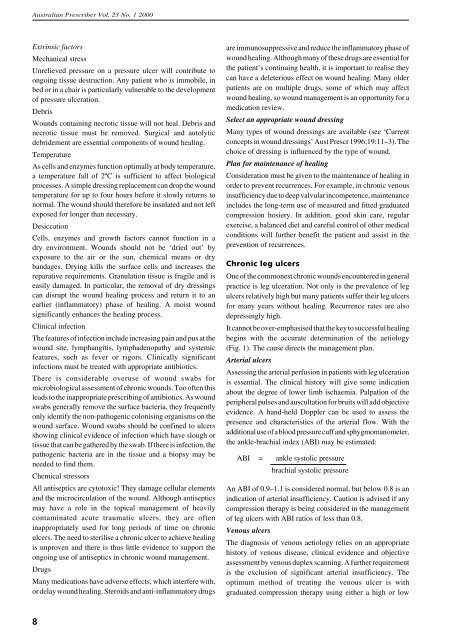PDF version - Australian Prescriber
PDF version - Australian Prescriber
PDF version - Australian Prescriber
Create successful ePaper yourself
Turn your PDF publications into a flip-book with our unique Google optimized e-Paper software.
<strong>Australian</strong> <strong>Prescriber</strong> Vol. 23 No. 1 2000<br />
Extrinsic factors<br />
Mechanical stress<br />
Unrelieved pressure on a pressure ulcer will contribute to<br />
ongoing tissue destruction. Any patient who is immobile, in<br />
bed or in a chair is particularly vulnerable to the development<br />
of pressure ulceration.<br />
Debris<br />
Wounds containing necrotic tissue will not heal. Debris and<br />
necrotic tissue must be removed. Surgical and autolytic<br />
debridement are essential components of wound healing.<br />
Temperature<br />
As cells and enzymes function optimally at body temperature,<br />
a temperature fall of 2ºC is sufficient to affect biological<br />
processes. A simple dressing replacement can drop the wound<br />
temperature for up to four hours before it slowly returns to<br />
normal. The wound should therefore be insulated and not left<br />
exposed for longer than necessary.<br />
Desiccation<br />
Cells, enzymes and growth factors cannot function in a<br />
dry environment. Wounds should not be ‘dried out’ by<br />
exposure to the air or the sun, chemical means or dry<br />
bandages. Drying kills the surface cells and increases the<br />
reparative requirements. Granulation tissue is fragile and is<br />
easily damaged. In particular, the removal of dry dressings<br />
can disrupt the wound healing process and return it to an<br />
earlier (inflammatory) phase of healing. A moist wound<br />
significantly enhances the healing process.<br />
Clinical infection<br />
The features of infection include increasing pain and pus at the<br />
wound site, lymphangitis, lymphadenopathy and systemic<br />
features, such as fever or rigors. Clinically significant<br />
infections must be treated with appropriate antibiotics.<br />
There is considerable overuse of wound swabs for<br />
microbiological assessment of chronic wounds. Too often this<br />
leads to the inappropriate prescribing of antibiotics. As wound<br />
swabs generally remove the surface bacteria, they frequently<br />
only identify the non-pathogenic colonising organisms on the<br />
wound surface. Wound swabs should be confined to ulcers<br />
showing clinical evidence of infection which have slough or<br />
tissue that can be gathered by the swab. If there is infection, the<br />
pathogenic bacteria are in the tissue and a biopsy may be<br />
needed to find them.<br />
Chemical stressors<br />
All antiseptics are cytotoxic! They damage cellular elements<br />
and the microcirculation of the wound. Although antiseptics<br />
may have a role in the topical management of heavily<br />
contaminated acute traumatic ulcers, they are often<br />
inappropriately used for long periods of time on chronic<br />
ulcers. The need to sterilise a chronic ulcer to achieve healing<br />
is unproven and there is thus little evidence to support the<br />
ongoing use of antiseptics in chronic wound management.<br />
Drugs<br />
Many medications have adverse effects, which interfere with,<br />
or delay wound healing. Steroids and anti-inflammatory drugs<br />
are immunosuppressive and reduce the inflammatory phase of<br />
wound healing. Although many of these drugs are essential for<br />
the patient’s continuing health, it is important to realise they<br />
can have a deleterious effect on wound healing. Many older<br />
patients are on multiple drugs, some of which may affect<br />
wound healing, so wound management is an opportunity for a<br />
medication review.<br />
Select an appropriate wound dressing<br />
Many types of wound dressings are available (see ‘Current<br />
concepts in wound dressings’ Aust Prescr 1996;19:11–3). The<br />
choice of dressing is influenced by the type of wound.<br />
Plan for maintenance of healing<br />
Consideration must be given to the maintenance of healing in<br />
order to prevent recurrences. For example, in chronic venous<br />
insufficiency due to deep valvular incompetence, maintenance<br />
includes the long-term use of measured and fitted graduated<br />
compression hosiery. In addition, good skin care, regular<br />
exercise, a balanced diet and careful control of other medical<br />
conditions will further benefit the patient and assist in the<br />
prevention of recurrences.<br />
Chronic leg ulcers<br />
One of the commonest chronic wounds encountered in general<br />
practice is leg ulceration. Not only is the prevalence of leg<br />
ulcers relatively high but many patients suffer their leg ulcers<br />
for many years without healing. Recurrence rates are also<br />
depressingly high.<br />
It cannot be over-emphasised that the key to successful healing<br />
begins with the accurate determination of the aetiology<br />
(Fig. 1). The cause directs the management plan.<br />
Arterial ulcers<br />
Assessing the arterial perfusion in patients with leg ulceration<br />
is essential. The clinical history will give some indication<br />
about the degree of lower limb ischaemia. Palpation of the<br />
peripheral pulses and auscultation for bruits will add objective<br />
evidence. A hand-held Doppler can be used to assess the<br />
presence and characteristics of the arterial flow. With the<br />
additional use of a blood pressure cuff and sphygmomanometer,<br />
the ankle-brachial index (ABI) may be estimated:<br />
ABI = ankle systolic pressure<br />
brachial systolic pressure<br />
An ABI of 0.9–1.1 is considered normal, but below 0.8 is an<br />
indication of arterial insufficiency. Caution is advised if any<br />
compression therapy is being considered in the management<br />
of leg ulcers with ABI ratios of less than 0.8.<br />
Venous ulcers<br />
The diagnosis of venous aetiology relies on an appropriate<br />
history of venous disease, clinical evidence and objective<br />
assessment by venous duplex scanning. A further requirement<br />
is the exclusion of significant arterial insufficiency. The<br />
optimum method of treating the venous ulcer is with<br />
graduated compression therapy using either a high or low<br />
8
















